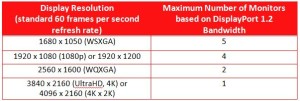The neopreme sleeve are 50$? What a rip! I found them at 15$ on the web. The only reason that I paid 25$ for it, is:
1) I am in Canada, and everything cost more, even things made in Canada by Canadian companies cost more in Canada than in the U.S.
2) I needed it, NOW. As University started, and my 5 year laptop could not be continued to be used.
As for the adapter. The Surface Pro 1 and Pro 2 uses mini-DisplayPort. This is a standard connector part of the DisplayPort group
DisplayPort | High Performance Digital Technology.
That is currently the best video connector you can possibly get. It is so ahead, that graphic card are catching up to it. Just recently Nvidia and AMD support the almost the full functionality of DisplayPort 1.2. You are suppose to be able to plug 4 (yes, 4!) monitor in daisy chain, and operate 4K resolution display, at 60Hz, at 10-bit colors (1.07 billion colors).
The Surface 1 and 2 (non-Pro) has mini-HDMI, as this is what the Nvidia Tegra chip inside (on both) supports, as this is what most OEMs wants to equip their tablets for. As these other tablets are entertainment focus and not work focused like the Surface Pro is. So does not support DisplayPort.. maybe the next Tegra chip.
Advantages of DisplayPort.
-> Supports more plug in's and out's than any other video connector around (HDMI, VGA and DVI), before breakage.
-> Consumes less power than any other video connector.
-> Carries error correcting bits like DVI, but unlike HDMI, to ensure that every frame displayed on your screen is perfect.
-> Can daisy chain multiple monitors together:
-> Internal laptop and tablet connector version exists for ultra low voltage operation, helping increase mobile devices battery life.
-> Support longer cable than DVI, and HDMI
-> Support the highest resolution by a long shot (4K 60Hz 10-bit colors. Dual-link DVI is limited to 2560x1600 at 8-bit colors. As for HDMI 1.4: 4K 30Hz 8-bit only)
-> Easier to produce cables, and connector making them inexpensive for the consumer
-> Holds better, and the full version of DisplayPort, has a latch system
-> Support encryption to support HDCP content (Blu-ray)
-> Carries audio and video, and can also carry an auxiliary source like USB or Ethernet (not implement by any graphic card manufacture, so not in use anywhere yet. Just audio and video together)
-> Royalty free. Means cheaper monitor, cables and devices for the consumer. HDMI royalty fees are sky high, that is why you see mostly old HDMI version in products, even on a new ones, as it cost too much.
-> Backward compatible with a simple inexpensive adapter down to: HDMI or single link DVI, or VGA with an active adapter.
HDMI was made for the TV space. And the only reason it was made, was to support copy protection system which was said to eliminate movie piracy forever... (yea we all know how that turned out). The only reason why it got support, was that it got big financial support from the movie industry. Sony wanted to make money out of a propriety connector (they love propriety stuff), and well.. if you join in, you get to pay no royalty fees. You don't... prepare to pay... a lot.
DisplayPort has over 200 technology company that supports it. Dell, Apple, Lenovo, HP, and NEC are the biggest computer manufacture that supports it.
DisplayPort is also hard at work for 2.0 which is set to support 8K displays Yes, 8K already. No release date known, or even approximate time. It is still in R&D sages, but it is their goal.
So, in conclusion, using DisplayPort is simply the best option. If the Tegra processor support DisplayPort, than the Surface non-Pro would have it.
The majority of buisness class systems uses DisplayPort, and now it is entering the consumer market at a slow paste, but it is coming in, replacing HDMI. It will take time, as the consumer wants HDMI, ignoring the fact that the cable would be cheaper, and that they can get an adapter for it.



